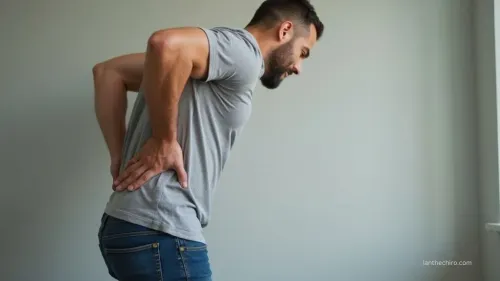Tailbone Pain in Malaysia: Why Sitting Too Long in Traffic Worsens Coccydynia
When you spend hours stuck in Malaysia's traffic, the constant pressure on your tailbone can trigger or worsen coccydynia.
Unsupportive car seats and poor posture make things worse, leading to inflammation and persistent pain. To prevent this, adjust your seat for good posture, use a tailbone cushion, and take short breaks to move or stretch. Keeping your back straight and avoiding slouching really helps.
Stick around to find smart strategies to protect yourself during those long commutes.
Understanding Coccydynia: What Causes Tailbone Pain?

Although tailbone pain might seem minor at first, understanding what causes it's essential for preventing discomfort during Malaysia’s long commutes. The coccyx, or tailbone, is sensitive to pressure, especially if you sit for extended periods or on hard surfaces. This pressure can trigger inflammation, nerve irritation, or even injury, resulting in persistent pain.
Poor posture makes things worse by placing uneven stress on your tailbone. If you have a naturally curved coccyx or have experienced trauma, you’re at higher risk of developing pain. During pregnancy, hormonal changes and pelvic adjustments can further contribute to tailbone pain.
To stay comfortable, use ergonomic seat cushions, maintain good posture, and take frequent breaks. These strategies help reduce strain and protect your tailbone.
How Malaysia’s Traffic Jams Worsen Tailbone Discomfort
When you’re caught in Malaysia’s notorious traffic jams, spending hours seated in your car puts intense pressure on your tailbone. Prolonged sitting, especially on hard or unsupportive seats, increases stress on your coccyx and limits blood flow, leading to inflammation and discomfort.
To minimise coccyx pain during heavy traffic, adjust your seat to improve posture and use a cushion designed for tailbone relief. Take advantage of every opportunity to shift your position, stretch gently at red lights, or briefly stand if possible during long stops. These small changes can help reduce muscle tension and prevent micro-trauma caused by repetitive stop-and-go traffic.
Prioritising good ergonomics and movement during your drive helps protect your tailbone and makes daily commutes more bearable.
Key Risk Factors for Coccydynia in Malaysian Drivers

Sitting in heavy Malaysian traffic for long stretches puts direct, constant pressure on your tailbone, especially if your car seat lacks proper support. Prolonged sitting increases the risk of coccydynia because it limits movement, weakens your pelvic floor and tailbone-supporting muscles, and allows pressure to build on your coccyx.
If your car seat is hard or ergonomically poor, this pressure gets worse, leading to inflammation and pain. The frequent stops and starts typical of Malaysian traffic can create repeated micro-trauma, aggravating discomfort.
To minimise risk, pay attention to your posture and ensure your seat offers adequate cushioning. Staying aware of these factors can help you protect your tailbone and pelvic floor, giving you a more comfortable and healthier commute.
How to Reduce Tailbone Pain During Long Commutes
Since Malaysian traffic often keeps you in your car for long stretches, taking steps to reduce tailbone pain becomes essential for your comfort and health. Start by using an ergonomic cushion with a cutout design to relieve direct pressure on your coccyx during prolonged sitting.
Long hours in Malaysian traffic make it crucial to use an ergonomic cushion to ease tailbone discomfort during extended drives.
Adjust your car seat to a more upright position, ensuring your back stays straight, shoulders relaxed, and feet flat on the floor, this posture minimises strain on your tailbone.
Don’t forget to take regular breaks: every 30 to 60 minutes, stand up, stretch, or walk briefly to relieve coccyx pressure.
Avoid slouching, as poor posture can worsen tailbone pain.
Treatment and Prevention Strategies for Lasting Relief

Although daily commutes in Malaysia can make tailbone pain feel unavoidable, simple changes to your routine offer real relief. Start by focusing on prevention strategies: maintain an ergonomic sitting posture and use a supportive cushion to minimise coccyx pressure during long drives.
Regularly take short breaks, stand, stretch, or shift positions to keep your tailbone from becoming stiff or inflamed.
Strengthen your pelvic floor and core muscles with targeted exercises to boost stability and decrease discomfort over time.
For immediate relief, consider treatment options like applying cold packs or heat therapy to reduce inflammation and soothe pain after prolonged sitting.
Frequently Asked Questions about Coccydynia
Can Sitting Cause Coccydynia?
Yes. Prolonged sitting, especially on hard surfaces, can irritate the coccyx and lead to coccydynia. Using a cushion and taking regular breaks can help reduce pressure and prevent tailbone pain.
What Makes Coccydynia Worse?
Sitting for long periods, poor posture, and hard or unsupportive chairs can all aggravate coccydynia. Improving ergonomics and movement habits is key to managing symptoms.
Why Does My Tailbone Hurt After Sitting Too Long?
Tailbone pain after sitting usually comes from sustained pressure on the coccyx. This can compress tissues and lead to inflammation. A coccyx cushion and regular posture changes can help reduce strain.
What Happens if You Sit on Your Tailbone Too Much?
Repeated pressure on the coccyx can cause inflammation, pain, and long-term sensitivity. Preventative steps like posture correction, cushioned support, and movement breaks are essential.
Stop the Jam Pain: Save Your Tailbone
Don’t let Malaysia’s endless traffic jams turn your daily drive into a torture session for your tailbone!
If you ignore coccydynia, you’ll feel like you’re sitting on a pile of rocks every day. Take charge, adjust your seat, use a cushion, and stretch every chance you get.
Prevent pain before it hijacks your life. A few smart moves can save you from a lifetime of discomfort and keep you cruising in comfort, no matter how bad the jam gets.














